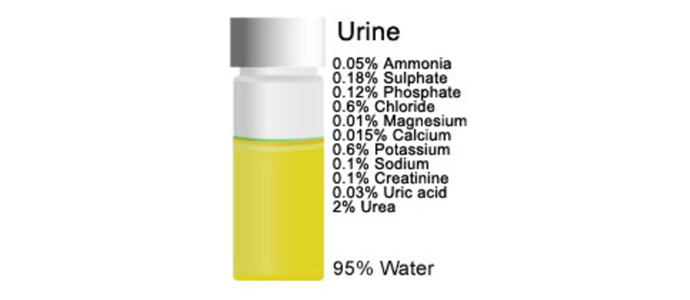Summary from Kerry Dawe
How many members use urine as free fertiliser?
1. Human urine is safe to use, and is high in NPK and trace elements.
2. Using urine as fertiliser recycles the nutrients and prevents them discharging as pollutants into the water table, rivers and oceans.
3. Recycling urine saves water. Half flush cisterns use 2.2ltr (6 star rating) to 6ltr (older model cisterns) of water per flush. The average person who drinks 6-8 glasses of fluid per day will pee 300-400mls of urine 5-6 times per day. Half flush will use 13.2ltr and 42ltr of water per day, per person depending on cistern efficiency…That equates to a water saving of around 5,000-15,000 ltrs of water, per person, per year, which can be used to dilute the urine and provide water to plants and lawns.
4. The average family of 4 produce the equivalent of 50kg of high quality NPK fertiliser as urine.
Amazon #ads

5. Urine is a free, natural ‘herbicide”. The Urea in urine is toxic to some weed species (ie. broomrape) and applying urine will help kill or control them.
6. Fresh urine should be diluted 1 part urine to 10 parts water or it can burn plants.
7 Urine more than 24 hours old breaks down into ammonia, and will kill plants so should only be used as a herbicide (to burn leaves) or added to compost heaps where it will accelerate breakdown into compost in addition to adding valuable nutrients.
8. Nappy pails with lids make excellent containers for women to pee in.
Human urine provides an excellent source of nitrogen, phosphorous, potassium and trace elements for plants, and can be delivered in a form that’s perfect for assimilation. With a constant, year-round and free supply of this resource available, more and more farmers and gardeners are making use of it.
What’s in it?
Urine is 95% water. The other 5% consists of urea (around 2.5%), and a mixture of minerals, salts, hormones and enzymes. It is a blood byproduct, but despite containing some bodily waste it is non-toxic.
The average urine from a healthy adult will release 11g nitrogen/urea, 1g phosphorus/super-phosphate and 2.5g potassium. The normal range for a 24-hour urine output is 800 to 2000 milliliters (ml) per day with a normal fluid intake of about 2 liters per day. That’s an average of 1400 ml per person, per day!
Fresh human urine is sterile and so free from bacteria. Only when it is older than 24 hours the urea turns into ammonia, which is what causes the distinctive smell. Antibiotics, vitamin supplements and other medications will end up in your urine, but in such minute quantities as to be negligible, especially when diluted in water.
How to use it
Urine can be used in a number of ways, such as a solution that is applied to plants to provide a quick, short term boost in growth or as a nitrogen additive to carbon based material, facilitating the composting process. I prefer to use urine for compost building or biomass production as I generally find long term fertility solutions preferable to quick fixes.
Let’s look at the various ways it can be used.
Plant feed solution
It is too strong to be used neat on most plants and should be diluted. Dilute one part fresh urine to 10-15 parts water for application on plants in the growth stage. Dilute one part fresh urine to 30-50 parts water for use on pot plants, which are much more sensitive to fertilisers of any kind.
Even when diluted your plants don’t need daily applications and it’s best used on plants that need lots of nitrogen, such as corn and squash, tomatoes and cucumbers during their fruit-bearing stage.
You can also use it to remedy nitrogen deficiencies. Signs of nitrogen deficiency include yellow or pale green leaves.
 |
| Nitrogen deficiency in Tomato (photo by http://www.haifa-group.com/knowledge_center/deficiencies/nutrients/macro_nutrients/n_nitrogen/) |
There is a danger of applying too much and the excess nitrogen can lead to bushy, leafy plants that attract aphids and bear little fruit. Signs of excess nitrogen include curled leaves,
Excess diluted urine can be used on lawns and trees.
Amazon #ads

Compost additive
Urine can be applied directly to the compost pile. As it’s very high in nitrogen, it should be added to plenty of carbon-rich materials, like dry leaves, sawdust, straw and cardboard. Urine can act as a starter for compost, encouraging the decomposition process. Undiluted urine can also be applied directly to heavily mulched soils serving the same function as above. The mulch should be thick enough to absorb the urine before it can make contact with plant roots
Straw Bale Stacks
You can urinate directly on a bale of straw and eventually the straw will decompose and can be used as compost or you can plant directly into the decomposing straw bales.
We use straw bale stacks which are, as the name suggests, simply a number of bales stacked up. These provide excellent habitat for overwintering toads and frogs. When the bales have decomposed the area is perfect for planting trees into. It’s weed free, with mulch and compost right where it needs to be. Build a new pile where you plan to plant a tree in the future and see the toads and frogs quickly move in. Aesculapian Snakes are also commonly found in our bale stacks along with a tremendous amount of invertebrates.
The bales on the ground surface will decompose within 12 months even without urine.
 |
| Common Toad – Bufo bufo and Aesculapian snake – Zamenis longissimus photographed within one of our Straw bale stacks. |
Applied Directly
Some plants such as Symphytum x uplandicum – Comfrey ‘Bocking 14’ can handle neat urine. Following cutting the plants, you can provide each plant with approx. 700 ml of undiluted urine.
 |
| Comfrey ‘Bocking 14’ – Symphytum x uplandicum growing in the under story of our forest garden |
This creates a great opportunity to cut out the dilution phase and produce good quantities of high quality nutrient dense mulch for your crops. This biomass when continuously applied to the surface of your beds will help create long term fertility in your gardens by building up the soil humus levels.
References:
- Human Pee Proven Fertilizer Future
- Urine the Ultimate Organic Fertiliser.html
- Human Urine is an Effective Fertilizer/
- Grow with the Flow
- NASA Contractor Report No. NASA CR-1802, D. F. Putnam, July 1971(PDF).
This article originally appears on the Balkan Ecology Project website, here.
Bonus: ‘P’ is for phosphate: Could urine solve a fertilizer shortage?






